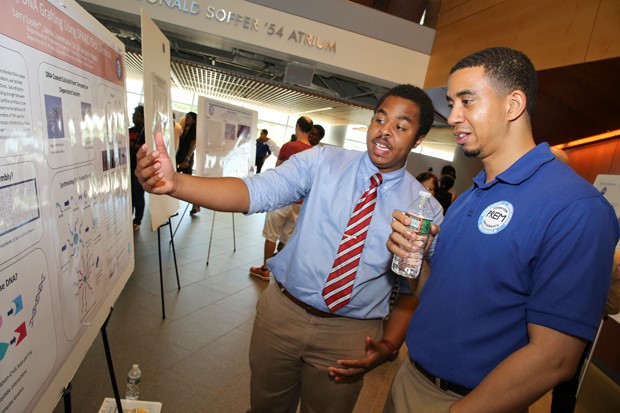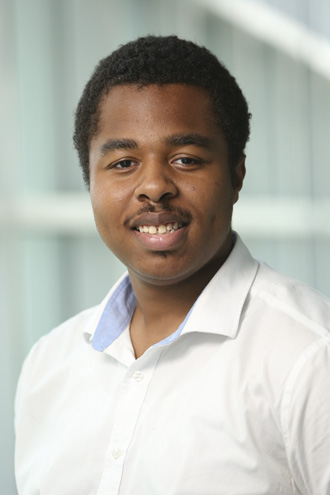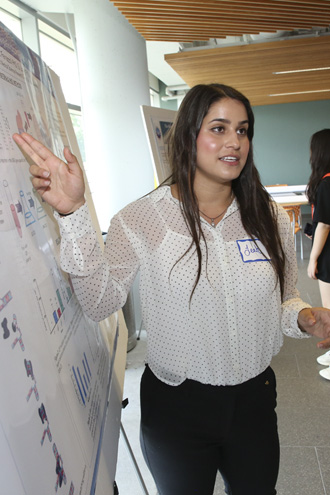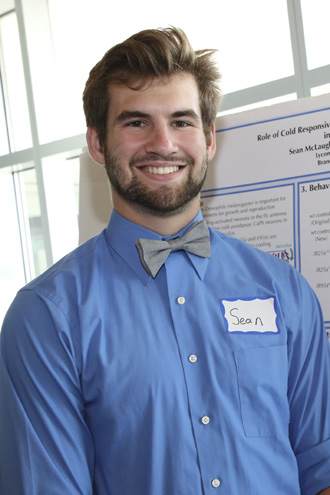SciFest VIII: The legend continues
An annual tradition, SciFest lets students present the research they did over the summer.
 Photo: Mike Lovett
Photo: Mike LovettLarry Luster, left, worked on using DNA to create a new kind of plastic material.
This year's SciFest, the eighth since the summer undergraduate research program started, featured 105 students presenting the results of their research working in Brandeis labs. The first and second floors of the Carl J. Shapiro Science Center were full of professors, administrators and graduate students perusing the displays.
The participants had spent at least 10 weeks this summer working on their projects, but many have been at it longer, having toiled away during the school year as well.
Over three-fourths of the student presenters attend Brandeis. Five are from Hampton University, a historically African-American university in Virginia. They worked in labs at Brandeis' Materials Research Science and Engineering Center (MRSEC) as part of a summer research program funded by the National Science Foundation. The rest come from other colleges or universities as part of Brandeis' Research Experience for Undergraduates (REU) programs.
Here's a sampling of this year's presentations:

Larry Luster
Larry Luster, Hampton University
High Density DNA Grafting Using SPAAC Click Chemistry Mentor: Assistant Professor of Physics W. Benjamin Rogers
We're on the cusp of the era of self-assembling machines when parts and pieces will come together on their own to form microscopic robots. Luster looked at a cutting-edge technique for building these kinds of contraptions that involves grafting strands of DNA onto small plastic spheres that are 100 times thinner than a human hair. The strands are made up of nucleotides that only pair with certain other nucleotides (A only binds to T, G only binds to C). When Luster set his experiment in motion, the DNA strands sought out their matching mates, hauling the plastic spheres along with them. In this sense, the spheres self-assemble, coming together without human intervention.
Luster studied a new approach, developed by scientists at New York University, that enables researchers to dramatically increase the number of DNA strands on each plastic sphere. It's a significant improvement over the process currently used in the Rogers lab. Luster looked at how changes in temperature affected the duration of the self-assembly process and the strength of the bonds that formed between the spheres.
Luster says right now we are in the information gathering stage, but that one day such self-assembling processes may have a huge impact on medicine, science and industry. Think of a box that can carry a drug through your body, then open and deposit its contents inside a cell, or a gel that can wriggle down a pipe, detect a leak and then repair it.

Leah Pearlman
Leah Pearlman '19
Practice Makes Imperfect: The Truth Behind Quasi-palindrome Mutations
Mentor: Abraham S. and Gertrude Burg Professor of Microbiology Susan Lovett
Yeast have roughly 5,000 genes. Pearlman looked at the relationship between 80 of them and their role in causing or preventing quasi-palindrome template switch mutations. Of these, she found five that may be implicated in causing the mutations that can lead to serious errors in the yeast genome. Pearlman said she hopes to develop a more efficient method of identifying culprit genes so she can test hundreds of others. "If we can figure out which gene is involved, we might be able to prevent such mutations from happening," she said.

Sean McLaughlin
Sean McLaughlin, Lycoming College (Williamsport, Pennsylvania)
Role of Cold Responsive Neurons in Driving Cold Avoidance Behavior in Drosophila melanogaster
Mentor: Professor of Biology Paul Garrity
McLaughlin researched in fruit flies’ (Drosophila melanogaster) cold response, zeroing in on so-called cooling-activated phasic (CaPh) cells in the insect’s antenna. Typically, flies placed in a laboratory chamber with one side at 61 degrees Fahrenheit and another at 77 degrees will head to the warmer area. When the flies are genetically modified to impair the functioning of the CaPh cells, they don't do this, suggesting that CaPh cells play a major role in their behavior.
McLaughlin manipulated neurons in flies using a technique called optogenetics, which involves using light to control brain cell activity in a living animal. When the neurons were altered, it changed the functioning of the CaPh cells. McLaughlin hoped to alter the CaPh cells’ activity so that the flies would no longer avoid the cool side of the chamber. Their cold response would be knocked out entirely.
As so often happens in science, he didn't succeed, though he did tamp down the cold response. McLaughlin believes he may have more success in the future by increasing the intensity of the illumination during optogenetic stimulation of these neurons.
McLaughlin's research may one day have bearing on understanding how mosquito-borne epidemics spread. Mosquitoes have a similar cold response to Drosophila’s, but their physiology is more complex than the fly's. It makes sense to start with the fly and build up.
Categories: Research, Science and Technology





